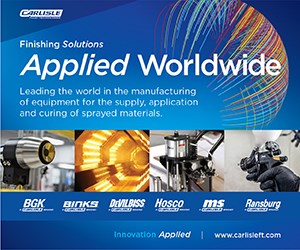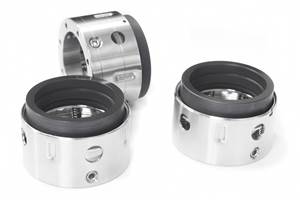Building Corrosion Control Facilities for Painting Military Aircraft
The U.S. government is experiencing a capacity issue for corrosion control maintenance for C-130 aircraft, but GFS’ Steve DellaSala explains how to get that business with a new system.
Q: Our facility paints large aircraft, but we would like to get into more work involving larger U.S. military aircraft. What advice do you have for building new corrosion control facilities?
A: According to industry experts, the U.S. government is experiencing a capacity issue for corrosion control maintenance for C-130 and Gen-4 jet fighters such as F-15, F-16 and F-18. The facilities available to properly strip and repaint these aircraft cannot keep up with the demands for refinishing. Solutions to this backlog will likely involve private sector investors building new corrosion control facilities to manage the work.
When considering a new corrosion control facility for C-130 aircraft, it is helpful to understand new technologies available for paint booths that comply with the latest federal and local codes. Since the earliest C-130 corrosion control paint facilities were put into service, both technology and codes have evolved. Some of these technology and code advancements can provide operational cost savings throughout the life of the facility.
Filtration: There have been significant improvements in paint booth filtration technology and code requirements over the past five decades. This is especially important when painting C-130 and Gen-4 jet fighters as the primers that have been used contain hexavalent chromium, a carcinogenic compound. Health effects of exposure to hexavalent chromium include lung, nasal and sinus cancer; eye, nose and throat irritation; nasal septum ulcerations; skin irritation; and gastritis or ulcers. To ensure effective reduction of chromate particles escaping into the atmosphere, the paint booth’s filtration system must meet national safety standards. Enforced by the EPA, the National Emission Standards for Hazardous Air Pollutants (NESHAP) for Aerospace Manufacturing and Rework Facilities require the use of a compliant filtration system for their paint finishing operation. Advancements in filtration technology include NESHAP-compliant, three-stage filtration systems that can capture at least 99.7 percent of particles larger than 2 microns. The advantages of a three-stage design can be realized in operational costs, as the first- and second-stage filters are less costly filters and sequentially protect the third stage (and more expensive filters) from overspray. This reduces the need to change out costly filters, thereby saving long-term maintenance costs.
Airflow: Many of the older aircraft crossdraft paint booths that exist today in the U.S. were designed and built without recirculation and with an airflow rate of 100 feet per minute (fpm). Today, 75 fpm is more typical in booths of this size. This reduced airflow rate decreases the operational expense of the booth, while still providing a safe, efficient finishing environment. In addition to a reduced airflow rate, the design of the C-130 paint booth can decrease capital and operating expenses. Some manufactures design conformal aircraft paint booths to accommodate the shape of the aircraft that is painted in it, with higher ceilings over the taller parts of the aircraft. A conformal design decreases the paint booth cross-sectional area in the direction of the airflow, which deceases the overall airflow cubic feet per minute (CFM) of the booth. Mechanical equipment, including Air Make-Up Units (AMUs) and fans, can then be reduced in capacity. With advancements in monitoring for lower explosion limit (LEL) and volatile organic compounds (VOCs), it is now much more common to see paint booths that recirculate about 75 to 80 percent of preconditioned, exhausted air back into the paint booth intake air system. These recirculation designs are less costly up front, as they also reduce the size of the mechanical equipment, such as AMUs. They also save on operational costs, as they do not require as much gas or electric heat; cooling from chilled water or electric-driven compressors; and ground water for humidification/dehumidification because most of the preconditioned air is reused instead of exhausted.
LED Lighting: There have also been improvements in Class I, Division 2 LED booth lighting. Upfront costs for LED lighting have reduced considerably from its early introduction. These light fixtures are now only a slight premium in cost compared to the entire budget for a paint booth. LED lighting offers the advantage of reduced operational and maintenance costs, as they are more energy efficient; give off a negligible amount of heat; do not degrade in performance over time; and do not require bulb changes as frequently as traditional fluorescent lighting.
If you are considering setting up a new corrosion control hangar for C-130 or Gen-4 jet fighters that includes paint booths, it is possible to save upfront and operational costs by taking advantage of new technologies and advancements in filtration, recirculation and lighting. The result will be a faster payback to your investment and higher quality finishes.
Steve DellaSala is a sales engineer in aerospace and defense for Global Finishing Solutions. Visit globalfinishing.com.
Related Content
Unique Coating Reduces Friction of Sliding Ceramic, Metallic, and Polymer Components
An extremely thin, hard diamond-like carbon (DLC) coating decreases the coefficient of friction (COF) of components to nearly zero, while increasing wear resistance.
Read MoreSmart Automotive Paint Booths: Embracing Industry 4.0
Automation, digitization, connectivity, remote process management tools help automakers, suppliers paint parts, vehicles at lower cost, reduced carbon footprint.
Read MoreMasking Solutions Provider CFS Dramatically Expands Capabilities and Capacity
Custom Fabrication & Supplies (CFS) completed a new plant expansion packing 10 times the capacity into twice the space. It dramatically enhances the supplier’s custom capabilities to provide extremely precise and cost-effective masking solutions.
Read MoreHenry Ford Is Still Right When It Comes to Color
Who would have imagined that more than 100 years after his famous statement about any color as long as it’s black would still have relevance of a sort?
Read MoreRead Next
Episode 42: An Interview with Robin Deal, Hubbard-Hall
Hubbard-Hall wastewater treatment specialist Robin Deal discusses the latest trends in wastewater management.
Read MorePowder Coating 4.0: Smarter, Faster, More Efficient and Connected
New tools reduce cost and waste, lower manufacturing footprint of powder coating operations.
Read MoreThe 2024 Ford Mustang: All the Colors Available
Although Chevrolet has announced the end of the Camaro and Dodge is offering “Last Call” editions of the Charger and Challenger, the Ford Mustang is launching to its seventh generation.
Read More

























